Perhaps someone’s remarked that you look angry or aloof. Or, you wonder why people approach your friends but not you. Here’s how to go from looking unapproachable and standoffish to approachable and friendly.
Sections
- How to be more approachable
- Looking more friendly and approachable
- Being more friendly when you interact with someone
- Dealing with underlying reasons for looking unapproachable
- How to be approached more
- How to be more approachable online
- How to be more approachable at work
How to be more approachable
Consider what makes someone approachable:
- Friendliness. We’re more likely to want to approach someone who is friendly and enjoys talking to new people.
- Kindness. We want to approach someone when they appear like a kind person. That way, we feel safe knowing they won’t make us feel bad about ourselves.
- Confidence. Confident people are often nice to be around; they can help us feel at ease.
- An ability to handle their own emotions. It feels good to approach people who appear to be stable. We know that how they treat us won’t vary too much depending on their mood.
- Positivity. Generally, people prefer to be around those who appear to have a positive outlook and who tend to show positive emotions.
With this in mind, here are some practical tips to help you be more approachable and open:
1. Have a friendly facial expression
Having a friendly facial expression means avoiding frowning, having a smile on your face, making eye contact, and being expressive.
For example, when someone approaches you, don’t stare at them. Instead, smile and say, “Hi.” If they don’t respond right away, you can add a simple question like “How are you?”
We talk more about how to look friendly in the next section.
2. Use open body language
Use an upright posture: Straight back with arms uncrossed. If you tilt your head back, you can come off as intimidating or stuck-up. If you tilt it down, you might come off as insecure or aloof. Therefore, keep your face vertical and your gaze horizontal.
3. Avoid covering up
Avoid sunglasses, hoodies, big scarves, or other things that cover you up. People get uncomfortable when they can’t see someone’s eyes or facial expressions clearly. Therefore it’s good to avoid obscuring your face. Covering your neck can signal that you’re uncomfortable. Since it’s a vulnerable area, exposing it or covering it (with clothing or a hand) has historically been an indicator of how comfortable we are.
4. Angle yourself toward people
Don’t look straight at strangers at mingles and parties, but in their general direction. If they, in turn, look in your general direction, you can make eye contact and give them a friendly smile. If you don’t look in people’s general direction, you won’t notice if they try to make contact with you.
5. Ask a trusted friend for their opinion
Tell a friend you trust that you think that you look unapproachable. Ask them why they think it could be. They might notice things about you that you had no clue about.
Be clear to your friend that you don’t want supportive words but their honest opinion on what you could do differently.
If you don’t have a friend or family member you can trust to provide you this feedback, consider working with a therapist, coach, or join a group course.
6. Keep a bit of extra eye contact
Look people in the eyes. When you greet people, keep a second of extra eye contact after you’ve shaken hands.
Eye contact makes friendly situations more friendly and hostile situations more hostile. Therefore, it’s important to keep eye contact with a relaxed face. Pro tip: Blink occasionally while you maintain eye contact to make it feel less like a stare.
7. Avoid acting busy when you’re not
Be present in the moment and avoid your phone when you’re around people. Practice looking at bypassers rather than at your phone. If you look busy, people will assume that you don’t want to be bothered.
8. Avoid standing too far away from others
When we feel uncomfortable, we often try to put distance between us and those around us (without even being aware of it).
One example is if we share a couch with someone and we start leaning away from that person. Another example is if we’re in a group conversation but don’t feel included, so we stand one step outside of the group.
If you notice that you stand far away from others, move a bit closer so that you are within a normal distance.
9. Choose to see people as old friends
Imagine that everyone you meet is an old friend. How would you react? How would you smile? What would your face and body language be like?
10. Make a positive remark if you want to talk
Making a positive remark signals that you’re open to interaction. It can be obvious and doesn’t have to be clever. Simply saying a few words is enough to let people know that you’re friendly.
“I love this view.”
“The bread smells so good.”
“This is such a nice house.”
Here’s more advice on how to start a conversation.
Looking more friendly and approachable
Follow these steps to learn how to look more friendly and approachable:
1. Relax your face
Nervousness can make us tense up without noticing. Remind yourself to relax the muscles in your face if you think that you might look tense. Make sure your lips and teeth don’t press together. You want your jaw to be just slightly open.
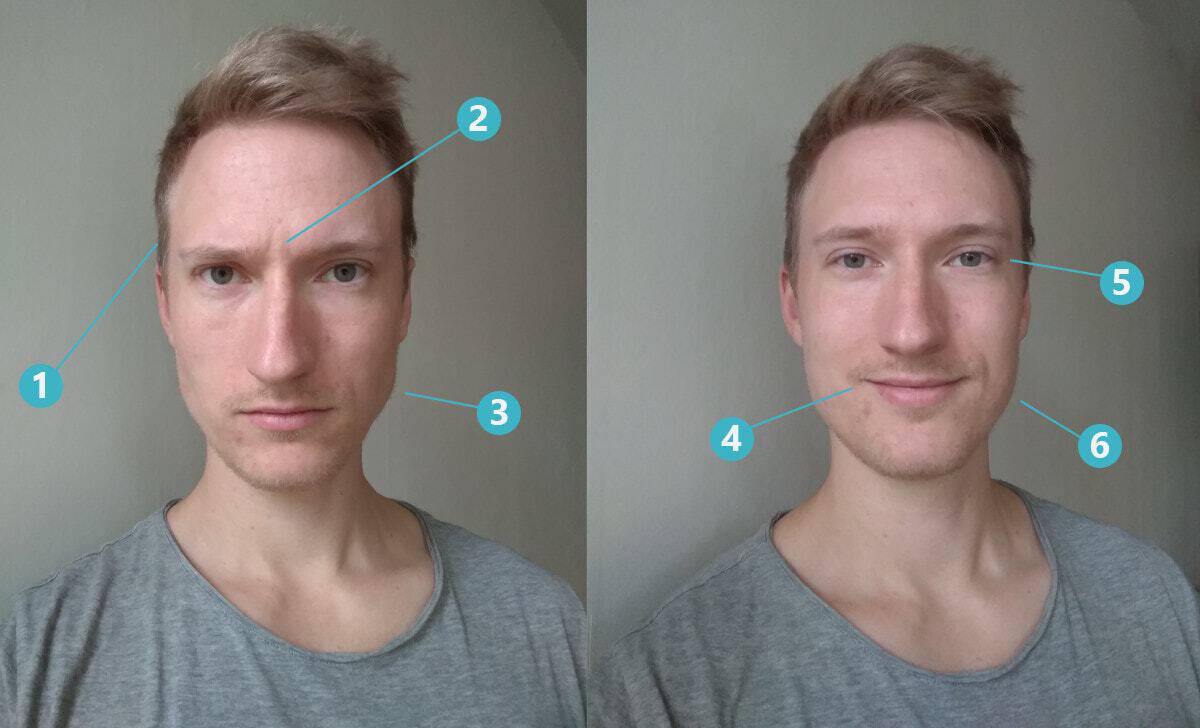
Unapproachable:
- Head tilted down
- Wrinkle caused by tense eyebrows
- Tense jaw
Approachable:
- Smile in the corner of the mouth
- Slight crow’s feet in the corner of the eyes
- Relaxed jaw
2. Practice a casual smile
Smile slightly with the corners of your mouth if you usually frown. It will feel weird before you make it a habit, but that’s normal. The smile can be very subtle—it’s more about canceling out the frown than grinning.
Having a resting facial expression that looks bored or angry is called RBF or Resting Bitch Face. For some reason, it’s associated with women, but it’s as common for men as it is for women.[1]
3. Smile with your eyes
Smiling with only the mouth and not the eyes can look insincere.[5] You know that you smile with your eyes when you get a slight wrinkle in the outer corner of your eyes that has the shape of a crow’s foot. Ease up a stern face by smiling slightly with your eyes together with a smile in the corners of your mouth.
4. Relax your eyebrows
Relax your eyebrows if you tend to lower them. Lowered eyebrows and the wrinkle between the eyebrows signals anger, even if we just do it because we’re uncomfortable or thinking about something that bothers us.[2]
5. Think of something that makes you happy
Think about something specific that makes you happy. Tap into that happiness and try to feel it in your entire body.
For example, you may feel happy when you think about meeting up with a specific friend for coffee. You can visualize the walk to the café and focus your attention on the positive feeling. You can try thinking of a pet, something funny you saw recently, or anything else that will make you feel good. This will make you feel—and look—happier and friendlier.
6. Avoid intimidating clothes
Avoid dressing in all black or in clothes that might make people uncomfortable approaching you. It’s great to express yourself with clothes. But when your goal is to look approachable, it’s better to avoid extremes.
Showing a lot of skin doesn’t necessarily make you more approachable. The same thing here: If you look TOO different from those around you, it can be intimidating.
On the flip-side, you can also stand out in a good way, for example, by having a colorful or unusual item on you or wearing an eye-catching outfit that enhances your looks and isn’t intimidating.
To know the difference, ask yourself if your outfit signals that it could be a positive or negative experience to approach you.
7. Be close to laughter
Sometimes it can be hard to laugh if we feel uncomfortable. If you are often stern around people, practice being a little more generous with what you laugh at.
8. Use a mirror to see how you look
Try out the examples above in a mirror. Compare the difference with and without adjusting your smile, eyebrows, and tension.
Use the mirror to make sure that you don’t overdo it. Even better is to take a video of yourself with your phone. It may feel more natural than looking at yourself in a mirror.
9. Make the most out of your appearance
Looking your best can make you feel more confident, which in turn can make you appear more relaxed and approachable.
Here are some examples:
- Make sure that your hair looks good and get regular haircuts.
- Wear clothes that make you look good.
- If you are very pale, spend 20 minutes in the sun daily.
- If you’re overweight, look up a sustainable weight loss diet.
Try getting into the habit of helping your future self feel and look better.
Being more friendly when you interact with someone
1. Dare to be warm first
It’s common to be standoffish if we’re a bit uncertain what the other person might think of us. To avoid rejection, we wait for the other person to be friendly before we dare to be. That’s a mistake because the other person is probably thinking the same thing.
Dare to meet the person like you would if you’d assume that they’ll like you:[3] Smile, be friendly, ask sincere questions, make eye contact.
2. Ask a personal question
Ask how people are and what they do. It signals that you’re open to interaction. The conversation can be very simple and what you ask isn’t that important. It’s just about signaling that you’re friendly.
– Hi, how are you doing?
– Good, how are you?
– I’m good. How do you know people here?
3. Use a friendly tone of voice
Use a tone that’s a bit friendlier if you usually sound harsh. Feeling nervous can tighten your throat and give you a stern voice. Ease up by practicing different ways of talking when you’re by yourself. One trick to sound friendlier is to use tonal variation. Use both high and low tones when you speak.
Here’s an example:
4. Be positive
Avoid talking about negative experiences or complaining, especially when you initially meet someone. Even though it may feel like you’re not negative toward the person you’re talking to, you might be seen as a negative person overall.
Dealing with underlying reasons for looking unapproachable
For some of us, there are underlying reasons for why we look unapproachable, such as anxiety or shyness.
1. Examine if you tense up because of nervousness
If you tense up, it could be because of underlying shyness or social anxiety. Read our guide here on how to stop being shy and how to stop being nervous.
2. Change the way you talk to yourself
Negative self-talk like “People won’t like me” makes us more hesitant to approach people. Ironically, this hesitation makes us look unapproachable, and when people don’t interact with us we think it’s because people don’t like us.
Change this by challenging your critical voice. If the voice tells you that people won’t like you, remind yourself of times where people did indeed like you.[4]
How to be approached more
This part is relevant if you want to be approached in a dating or flirting context.
“I’m relatively good-looking, but my friends get approached way more. I’m afraid that I look unapproachable. How do I get approached more by guys?”
The advice you’ve received so far in this guide is relevant here as well. Here is some additional advice specifically for being approached more.
1. Keep eye contact and smile
If you make eye contact with someone, keep that eye contact a second extra and smile. You can blink once to avoid coming off as staring. Subtle flirting like this signals that you’re friendly and makes it much less scary for someone to come up to you.
2. Avoid only going out in large groups
Large groups make it scary for someone to approach you. The social shame is naturally much higher if the approach doesn’t go well when there are more people to observe it. You’re likely to be approached more if you’re by yourself or with only one or two other friends.
3. Behave more like you do when you’re relaxed
When we get nervous, we tend to restrict ourselves. Think about how you are when you’re with close friends in a safe environment. If that’s more like you, your authenticity will make you more attractive. Try to notice how you behave differently and make a choice to act more like that in public.
4. Dare to take up more space
When we feel uncomfortable, we tend to take up less space, both in conversations and physically.
When you’re out, you can practice taking up more space by taking a walk around the venue without having a specific goal other than to “check it out.” It can feel uncomfortable at first but helps you expand your comfort zone. In a conversation, practice sharing your opinion on a subject even if it feels uncomfortable to have everyone’s eyes on you.
Don’t be overly loud or overly dominant. That can come off as over-compensating and signal insecurity
How to be more approachable online
If you want to make friends online but people seem reluctant to talk to you, you might need to work on appearing more approachable and open to conversation.
1. Use emoticons
Using emoticons (emojis) can help others read your tone and message correctly. Since we don’t have verbal and visual cues online (like the tone of voice and body language), it can sometimes be hard to know when someone is joking or being serious.
Emojis can also add extra “character” to regular messages. For example, “tell me more” becomes more playful with an eyes emoji, and “I love your shirt” comes alive with a heart eyes emoji. We can use these little icons to stand in for facial expressions, body language, and vocal tone.
The website Emojipedia can help you understand the meaning behind different emojis and how to use them better.
2. Respond quickly
People are more likely to approach you if they know they can count on you to respond in a timely manner and hold up a conversation. You don’t always have to respond in a matter of seconds, but if you’re in the middle of a back-and-forth, it can help if you let the person talking know if you disappear from the conversation.
If you’re shy about responding to people online and take a lot of time to come up with replies, read our article: What to do if you’re shy online.
3. Be encouraging
Practice being generous with praise online. When someone posts something you like, let them know. Try to take time to reply instead of just clicking a like button. Some examples of things you can comment include:
- “What a fantastic post.”
- “Thank you for being vulnerable.”
- “I love the colors and perspective you used in your painting.”
- “That is so creative. How did you get that idea?”
Even clicking a “heart” reaction button instead of a simple like can give a friendlier vibe online.
4. Let others know they can contact you
If you spend time on public groups, forums, or Discords, it can be helpful to end some of your posts with something like, “Feel free to reply or message me privately if you have any questions about this or want to talk further.”
5. Avoid giving abrupt answers to messages
When someone messages or texts you, try to avoid giving one-word answers to their questions and leaving long pauses between messages.
To be more approachable, try asking questions, answering quickly, and explaining why you are unable to text back if you’re busy. For example, “Hey, I’m good, how are you? I’m just studying for the test, have you started? I’m going to be doing a practice exam in half an hour, so I won’t be able to respond for a while.”
How to be more approachable at work
You’re more likely to enjoy your job and make friends at work if you look approachable and appear positive.
1. Keep complaining to a minimum
Complaining with someone can sometimes be a bonding experience, but it’s best to avoid it when you’re trying to be more approachable. People are more likely to approach you if they assume talking to you will be a positive experience.
Make a conscious effort to talk about neutral or positive things, like hobbies. Avoid saying things like, “I hate it here” or talking about your personal problems.
For more, read how to socialize with coworkers at work.
2. Follow the dress code
Today, the dress code is different at every job. Some workplaces are very casual, while others expect more “professional” clothing. If you want to look approachable, it’s best to dress in a similar way to other people in your workplace.
As a general rule, make sure your knees and shoulders are covered. Try to pick “plain” tops, which means avoiding shirts that have provocative language or drawings. Button-down shirts for men and nice blouses for women are usually a safe bet.
3. Don’t be defensive
Often, at work, you’ll be approached with complaints or criticism. In some cases, you may have to give others reviews on their work. If you’re overly sensitive, this may be hard to deal with. Work on how you respond to negative feedback. If you tend to get upset or angry, other people may decide you are unfriendly and unapproachable.
For advice on handling difficult conversations, read how to overcome your fear of confrontation (with examples).
4. Be inclusive
Even if you like some of your colleagues much better than others, try to be friendly to everyone. Make them feel included. That way, you’ll come across as approachable and socially skilled.
Let’s say you’re in the middle of a conversation and a third person says something.
Answering in a low tone, giving short answers, making it unclear whether or not they are invited to join the conversation would make you seem unapproachable. For example, saying, “Yes, we know” without friendly body language or giving an invitation to join the conversation would make you appear cold or impolite.
To appear more approachable, you could try smiling at the person, moving your body to make space for them in the conversation, and giving them a verbal invitation to join the conversation. For example, you could say, “We were just talking about that, actually. Are you familiar with this topic?”
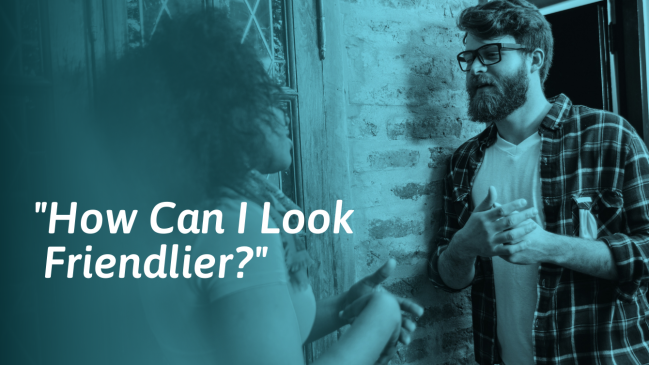



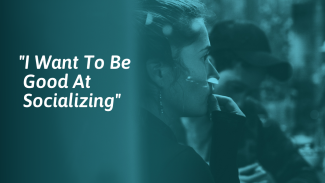



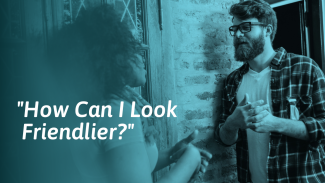

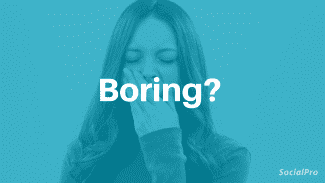
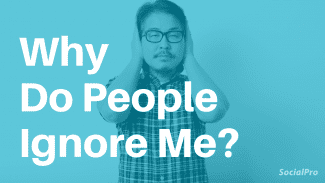
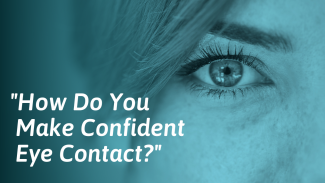


You guys are awesome
Thank you to the entire Socailself Team. This is an awesome writing. Very helpful and Informative
I take after my mom and have a RBF naturally and am a Goth so i understand i have reasons people find me unapproachable but even amongst Goth people I can’t seem to make any friends????will try your tips and thanks so much for the advice????
ok so i recently took a personality test and i got green and one of greens meanings is that i have barley any facial expressions whatsoever. so i need alot of help. is there a way i can fix this!??!!?!?!
I love all David and Viktor’s advice. :0)
<3
Wow, this was so helpful to hear, especially right now. I just started uni a few days ago and was feeling a little down and left out; so I I’m definitely going to follow through on this advice and hope for the best! ?
Your comment put a smile to my face, so I’m sure you will put smiles on many more people’s faces soon =)
Thank you for this public service!
You’re most welcome! 😀